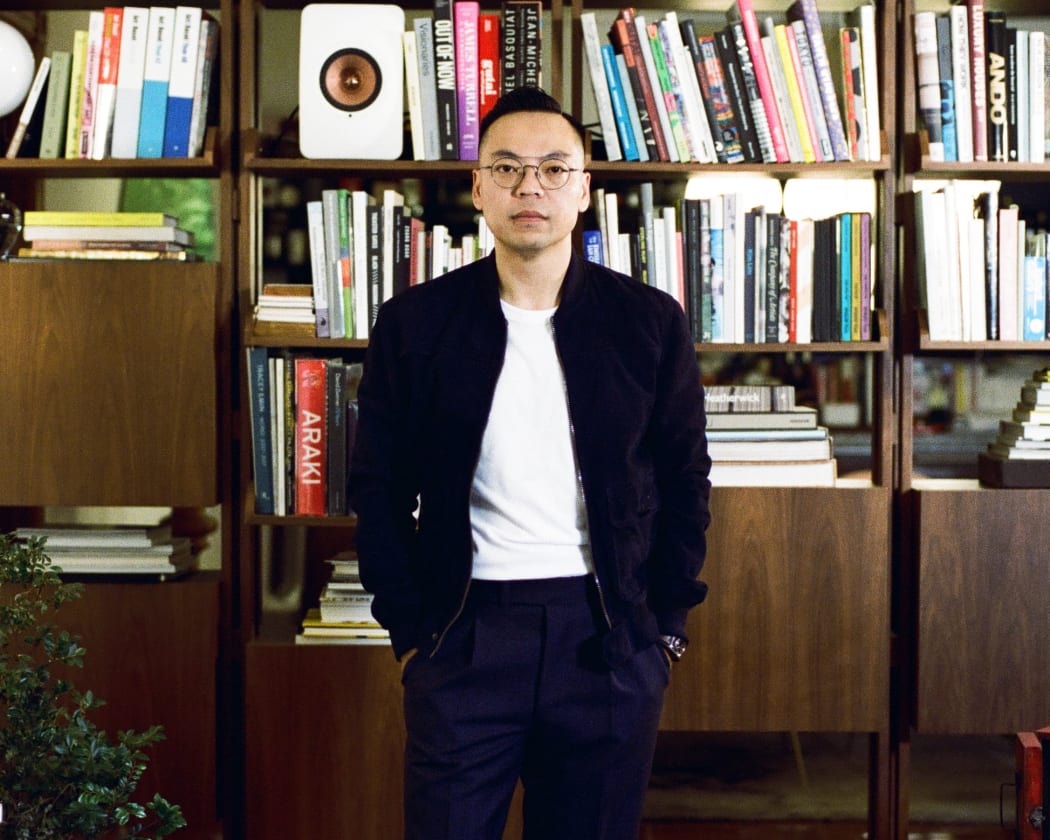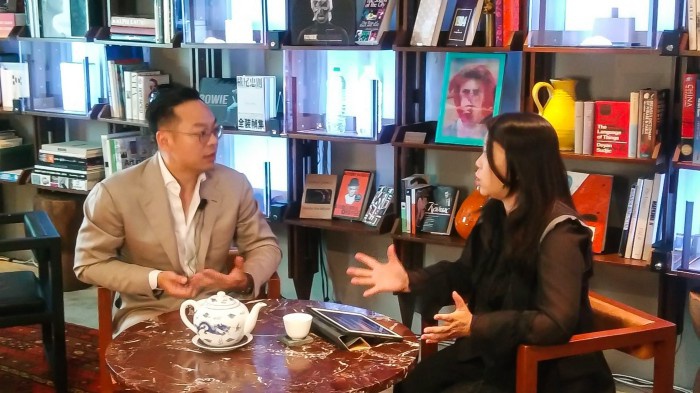
THIS WEEK ON ORA-ORA LIVE WE SPEAK TO ART PATRON AND COLLECTOR ALAN LO ON HIS ART COLLECTING JOURNEY.
Dr. Henrietta Tsui-Leung as Henri
Alan Lo as Alan
Henri: I’m delighted to be able to be here at Duddell’s and to be interviewing Mr. Alan Lo. Welcome, Alan.
Alan: Thank you. Thanks for having me.
Henri: We’re here at Duddell’s today. This is such a special place to host this interview. Not long ago, just a few years ago, I remember coming here for the first time being really curious about what an “art salon” means — this is the first art salon, art club in Hong Kong. I was very encouraged because we’d never seen something like this before. So Alan, to begin with, can you tell us something about this idea of yours?
Alan: We came up with the idea of creating this space in Hong Kong where people who are professionally involved in art and people who have an interest in art could come together to eat, drink, socialize and also learn a little bit about art. Which is why we made a point to create a very robust art and exhibition programme that is very much curator-led. It’s not just a few pretty things on the wall. It’s a conversation; it’s an ongoing dialogue, a discussion.
We do film screenings and salon chats, so there’s a lot of that going on here throughout the last seven years. This is not your traditional White Cube kind of space. It’s almost a bit like curating a show in a collector’s house. Yes, there are challenges in terms of how we do these projects in the context of a restaurant environment where a lot of people come in and out of the space. Obviously, our staff are trained to take good care of the art. We’re also fortunate enough to have great customers who are collectors, people involved in the auction world and galleries, and patrons who have a certain understanding of art. Of course we also get a great deal of other types of people who previously have not been exposed to the art world. But even if we can get two out of a hundred of those to pick up on the subject and become interested, I think we’re already doing the community a service.
Henri: So do you have any ink work in your collection that is not from your dad?
Alan: I don’t. I don’t have ink work, but from time to time I would loan works from our family collection to display in our home and office. If we have to talk about domestic curation, we do try to mix in 10 to 20 percent of ink into some of the more contemporary works.
Henri: I’m very curious. You mentioned your dad’s influence and you grew up, by default, surrounded by lots and lots of works, and had lots and lots of opportunities to meet these amazing ink artists. I guess you’re still not inspired to continue working with ink. But I want to explore whether this upbringing would build up a taste in your aesthetic or concept that influenced you as a collector?
Alan: I’m not opposed to ink as a medium, but what I’m interested to see is for contemporary ink artists to look at the macro, the practice, the thinking, the philosophy — how one can get out of its constraints. I think a lot of artists get boxed in to what is traditionally considered ‘ink’. Sometimes I look at contemporary ink, and think to myself, “This is not very contemporary.” I’d think, “This is ink done in contemporary days, but it’s still not contemporary.”
Henri: It’s still modern ink.
Alan: I think it’s okay to have a certain art history basis, but I guess the main difference between modern and contemporary is the way you look at and value aesthetics. It’s very different in the context of contemporary. I suppose a lot of ink artists are still — I don’t want to say “stuck” — quite immersed in the aesthetic.
Henri: That’s right. I agree. That’s one thing I really wanted to talk to you about from your background.
Alan: Sorry! I don’t mean to offend anyone.
Henri: No, no. It’s a serious topic. You are somebody with a profile who is serious in collecting and spending time and effort in helping the arts in general. But then given your background, you haven’t actively continued to collect ink. That’s not your problem, that’s a situation. It is something that somebody like me, who is focusing on this, has to think about. Like how to, not indirectly influence our artists, but to enlighten them and to guide them to think about these things.

Alan: There’s also the gallery system. In the 80s and 90s, there used to be dealers who played an important role in building the career of quite a few important 20th century ink artists and it seems like we don’t see a great deal of them today. Even if now they have become more historic artists there’s not — if we have to look for a Hauser of Ink, there isn’t one.
Henri: There isn’t one. There are a few of us in Hong Kong, but then we spoke about this before. Having just Hong Kong galleries presenting ink is not enough, we do need galleries in China and Taiwan and eventually hopefully in the West to be interested and to invest a lot of time and effort into promoting and introducing ink art.
Alan: If we look at it in an international context, the more we need to think about institutions. From a curatorial standpoint, we need to consider what is the relevance of ink in a wider context.
Henri: Exactly. For example, what kind of value do they bring to the museum system and other institutions? You’re talking about this because you have a lot of experience and exposure as an art patron. You volunteer a lot of your personal time and effort in supporting a lot of institutions like the Tate Modern, SFMoMA and Serpentine Gallery, etc. I want to discuss this concept you brought up when we were preparing for this discussion about experience versus ownership. You were asking me, “Do we actually need to own all these art? How important is “experiencing” to the public? What are your thoughts on that now given that you have put so much thought on it?
Alan: Well, first of all I think it’s an honour to be invited to serve on different committees with all these great international institutions. For me, it’s a great learning experience to understand how international art institutions and museums operate, how they achieve their mission and strategy in terms of collecting, and also at the same time how they bring art to the people. Hong Kong has come a long way, but I think we still have a long way to go. The next 15 to 20 years will be super interesting. I think, down the road, Asia will find its own way and will have its own museum system. But obviously the West, the likes of MoMA or the Tate, has been doing it for generations so it’s still a good model to reference.
Henri: What are the things you’re seeing that are important in order to make this happen? How important are art patrons to the art scene in general?
Alan: I think Hong Kong will always have an important role to play. Obviously, politically, we had a situation last year that persisted for a little too long. But in hindsight I think the M+ project is still a very important one. When it opens towards the end of next year, I think it really will redefine the whole Asian art and culture landscape. I think a lot of people still don’t realise the potential and the importance of the project.
Henri: Its magnitude.
Alan: I remember we talked about the millennial generation and how they no longer look at physical ownership as much. I think to a lot of millennials no longer think, “I make a good living and so I have to buy a fancy sports car and a house. I have to own a checkbox of things in order to be seen as successful.” I think success is defined by people who have the ability — change makers — ability to make changes, positive changes. They want to become change agents. In the context of art and culture, to this generation, I think it’s much more meaningful to donate money to an institution to acquire an important work rather than owning the work themselves.
Henri: Right.
Alan: I think we’re going to see a shift down the road. We are used to seeing art patronage mostly in the West, but slowly in Asia, with the millennial generation, it’s going to change.
Henri: That’s great. I’m looking forward to seeing a lot more of these opportunities for change and hopefully, apart from art patrons, there are ways for normal, average people to make a change too. It’s very hard.
Alan: I think we’re talking about the democratisation of art because art ultimately is sometimes, or a lot of the time, seen as a very elitist subject or hobby, or however you see it.
Henri: Yes, you did mention that.
Alan: I think there’s a shift in the behaviour with the younger generation. People are looking for an experience, rather than physical ownership. I think democratisation will happen way faster than we think.
Henri: Thank you so much, Alan.
ABOUT ORA-ORA LIVE
Each week, Ora-Ora will speak with various members of the art community — including artists, curators, academics and other professionals working in the cultural sector — to address topics of interest related but not limited to Hong Kong’s art and cultural scene. The series aims to be an outlet for creativity and a means to connect with peers who share similar interests. The episodes will also available live on Ora-Ora’s Instagram (@galerieoraora), Facebook (Galerie Ora-Ora) and later on Ora-Ora’s YouTube channel.